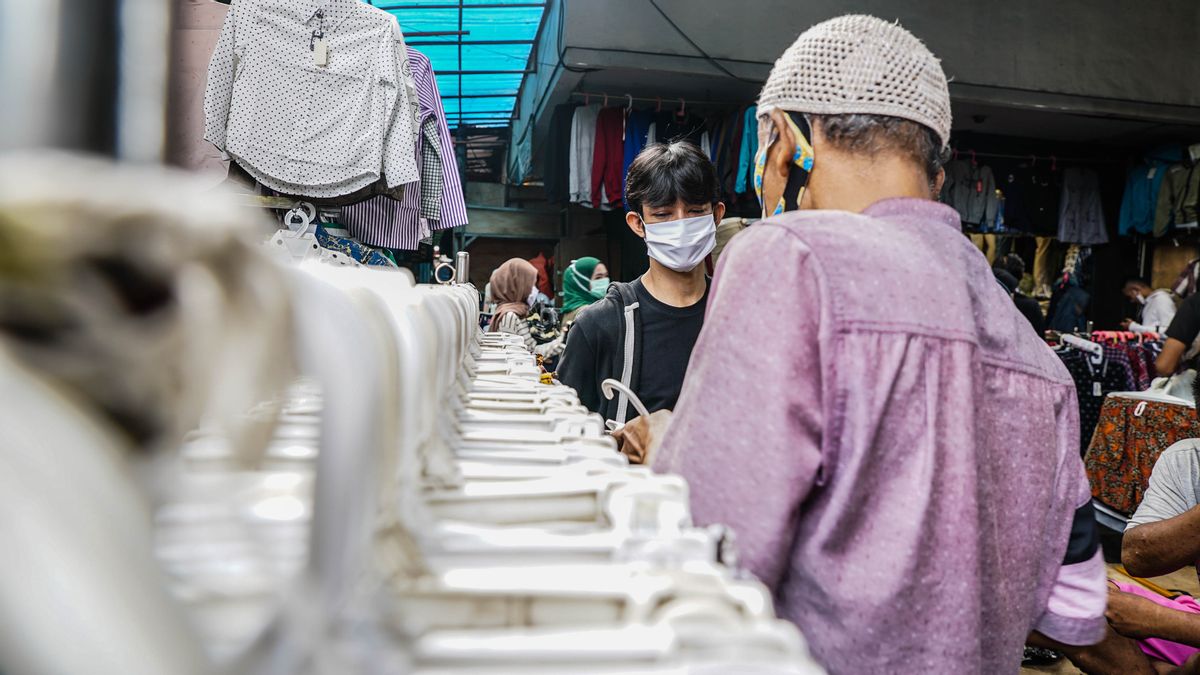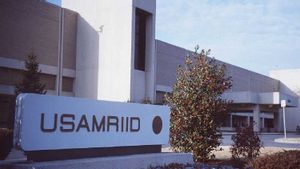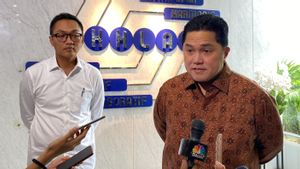JAKARTA - The thrift shop is currently being discussed on social media. The point of the debate is that many thrift shop selling prices are considered expensive. Thrift shop shouldn't be expensive. There is a long historical and cultural mission that must be accounted for by thrift shop business people, especially those engaged in clothing commodities.
In terminology, thrift shop means the activity of buying used goods. Tracing history, the thrift shop culture, which is generally engaged in clothing, was formed as a resistance to the consumptive culture of fast fashion. The thrift shop culture also carries an environmental mission to reduce textile waste with the concept of reuse.
The history of thrift shop began to build in the 1760-1840s range. The industrial revolution of the 19th century introduced mass-production of clothing which changed the way people saw the world of fashion. Back then clothes were very cheap. People will throw away the clothes they have worn.
The perspective of clothing as disposable or disposable items provokes the growth of the behavior of using used clothing which is usually still very suitable for use. This behavior develops and spreads as a culture in various countries of the world. In the UK, used clothing trends were widely used in the 1980s and 1990s. In the United States (US), the history is complex.
August 17 is the day on which Americans celebrate National Thrift Store Day. Reported by Time, Wednesday, November 18, National Secondhand Shop Day will be commemorated by specific shops across the country by offering insane discounts. This was done to remind people about this culture.
The thrift shop culture does not spread easily in the US. Before the 19th century, people were not used to selling their clothes. Historian Jennifer Le Zotte, author of From Goodwill to Grunge: A History of Secondhand Styles and Alternative Economies, explains that nothing was wasted before the thrift shop era.
"If you have a dress and it gets worn, you will tear it and make a pinafore for your daughter. And when the dress is destroyed, you will tear it and stuff your chair," she wrote.
The thrift shop era began in the late 19th century. Cities are growing fast. The historical spike in new arrivals occurred during America's biggest immigration wave. The industrial revolution introduced mass production of clothing. The game changes. As explained above, the price of new clothes is becoming more affordable and many people think of clothes as disposable.

Le Zotte explained that as the urban population grew, the size of living space shrank, causing more property to be thrown away. In addition to better waste management systems, pawnshops and scrap materials sprang up during this period in an attempt to find new uses for these items.
However, there is a stigma attached to wearing used clothes belonging to foreigners. Not only is the item itself a sign of a lack of money, but there is also bias against the person selling it. Second hand clothes are often available from wheelbarrows, started mostly by Jewish immigrants. At that time, the choice of the Jewish immigrant profession was severely limited by anti-Semitism. The prejudice is transmitted to their merchandise.
The Saturday Evening Post, of May 3, 1884, once ran a satirical tale of a girl who got smallpox from a dress she bought at a Jewish thrift store. However, the economic opportunities had been read by then. One group of the people who have been at the forefront of benefiting economically from this trend are Christian ministry groups seeking funding for their outreach programs.
In Indonesia, thrift shop culture is also developing. The culture expanded rapidly to various regions. Even thrift shop has a different designation in each region. Like the Bandung people who call it "cimol" or "awul-awul" for some people in East Java. Another, among the Hitaan (North Tapanuli) people, the thrift shop is known as "burjer.
In business, the thrift shop business initially developed in the coastal areas of the Indonesian sea. Areas bordering neighboring countries, such as Sumatra, Batam, Kalimantan, and Sulawesi have become entry points for imports of used clothing. Increasingly, the used clothing import business is expanding to Java Island. All sell as "imported goods" instead of labeling their wares "second hand". Unlike the UK or the US, in Indonesia, buying used goods is an insult to their own prestige.
Thrift shop to balance fast fashion
Reported by Katadata.co.id, throughout the first quarter of 2019, the textile and clothing industry experienced a significant increase with 18.98 percent growth. This achievement in the first quarter of 2019 was much higher than the achievement in the first quarter of 2018 which was in the range of 7.46 percent, even exceeding the achievement in 2018: 8.73 percent.
Data from the Central Statistics Agency (BPS) also showed an increase of 4.45 percent per year in the production of large and medium manufacturing industries in the first quarter of 2019. This increase was supported by the production of the apparel industry sector which shot up to 29.19 percent. The jump in orders, especially from the export market, was the trigger.
The growth of the fashion industry is followed by environmental threats from textile waste. United Nations Climate Change News explains the fashion industry contributes 10 percent of greenhouse gas emissions arising from long supply chains and the use of energy in intensive production.
2018 data shows the fashion industry generated 2.1 billion tonnes of CO2eq. This represents 4 percent of global carbon emissions, with most of the emissions created by the three big industrial countries, such as France, Germany and the UK.
Medio 2000 and 2014 were the periods in which the fashion industry developed the fastest. Manufacturers are producing twice as much clothing with the average consumer buying 60 percent more clothing than it was 15 years ago. Other data shows that nearly 20 percent of global wastewater is produced by the fashion industry.
The fashion industry also uses a lot of water. At least 20 thousand liters are needed to produce one kilogram of cotton which is equivalent to one t-shirt and jeans. Cotton farmers are also responsible for 24 percent of insecticides and 11 percent of pesticides, even though they only use 3 percent of the world's arable land.

[/ read_more]
Quoting data from the United Nation for Climate Change website, consumers are still used to throwing away shoes and clothes with an average of 70 pounds per person each year. Several stakeholders and communities established a textile recycling program, where 85 percent of this waste goes to landfills and occupies about 5 percent of all space in landfills.
Simultaneously, the used textiles will be reprocessed into new clothes. However, recycling is not enough. Other efforts are needed to balance the rapid production of the textile industry and human consumption of fashion items.
The reuse trend is the opposite of that culture: fast fashion. One of the derivatives is the thrift shop. The thrift shop provides space for the zero waste concept to take place. The availability of cheap goods that are suitable for use attracts many people to join this movement.
The rotation is important to suppress the textile production cycle which has an impact on environmental pollution. And more than that, the thrift shop has grown into an industry that creates big bucks in it.
Should it be cheap or expensive?Bayu Randy is a thrift shop entrepreneur. He recently opened a shop in the Lenteng Agung area, South Jakarta. His business began to develop around 2017, when Bayu, who previously only sold used jackets, pants, and t-shirts, began selling more fashion items, such as shoes, hats, and skateboards. Yes, for Bayu, skateboard is a fashion item.
Bayu has also started to upgrade his merchandise, both in quality and in brand curation. The move that Bayu has taken in the past two years has increased the selling power of his shop, 60:40.
"This is different from the first time I started. Indeed, since adding items, including a tighter selection, I have become more advanced," said Bayu to VOI, Wednesday, November 18.

[/ read_more]
Bayu conveyed his perspective to us, about why many thrift shop-based fashion items are now being sold at high prices. He is of the view that this will develop naturally as the thrift shop industry matures, where business actors begin to realize the importance of maintaining the quality of their merchandise.
Yes, even though Bayu is also aware of the number of sellers selling thrift shop goods at unreasonable prices. But, in Bayu's eyes, that is how this industry develops. "Besides, is it expensive or cheap, relatively not, huh?"
Annisa Rahmadhani, a thrift shop fan, said the same thing. According to him, expensive or cheap goods must be seen from the fashion items. Especially in a thrift shop. Such things become art.
"It depends on the goods. It depends on the brand, model, output (year). Because we are talking about thrift shop, we are talking about rare items as well. The rarer, the more expensive," said Annisa.
Even so, Bayu or Annisa realized that the economic aspect was not the main thing underlying the thrift shop culture. However, the thrift shop has a historical and cultural mission, even moral - including environmental issues, as we explained above.
"It must be different, yes. If it is a matter of cultural history, maybe it shouldn't be expensive," said Bayu.
"If I look at this to save the earth either? If we talk about the recycle or reuse cycle, to keep going (this movement) it should be sold cheaply. Need as many people as possible, right?" Women.
[/ read_more]
The English, Chinese, Japanese, Arabic, and French versions are automatically generated by the AI. So there may still be inaccuracies in translating, please always see Indonesian as our main language. (system supported by DigitalSiber.id)













